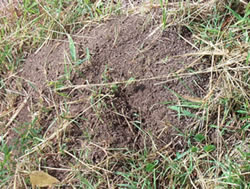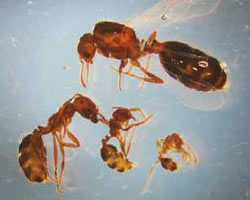Reproduction
Solenopsis invicta, more
commonly known as the Red Imported Fire Ant or RIFA, is one of the most successful invasive
species on the planet. Therefore, they must be very quick and
efficient at reproduction (Taber 2000). The mating of
these ants is a unique
process, and usually occurs between spring and fall. However,
they have been known to mate in the winter in places where climates
are warm (Taber 2000). Winged males and winged females, called
alates, engage in a mating ritual while in flight (Smithsonian
Marine Station 2007). Amazingly, some of these mating individuals
have been captured at heights approaching 1000 feet in the air
(Taber 2000). The male dies shortly after the mating process
concludes. Females remove their wings after the mating ritual as
well, so they can en compass their reproductive roles more
entirely (Klotz et al. 2008). The female, or queen, then finds
a suitable location to begin a colony (Smithsonian Marine
Station 2007). She will then dig chambers into the ground, where she
will lay her initial batch of eggs (Entomology and Plant
Pathology 2013).
compass their reproductive roles more
entirely (Klotz et al. 2008). The female, or queen, then finds
a suitable location to begin a colony (Smithsonian Marine
Station 2007). She will then dig chambers into the ground, where she
will lay her initial batch of eggs (Entomology and Plant
Pathology 2013).
Once eggs are laid by the queen, she covers them with
antibiotic venom to protect the offspring, which may also be
used as a signal for workers to carry them away to a different
part of the nest. However, the first batch
of eggs is raised in a way that differs from the future
generations to come. These eggs are nourished by the queen
herself via nutritious trophic eggs, oil she has regurgitated, or her own
saliva (Smithsonian Marine Station 2007). These first eggs are
hatched, but are smaller than future generations due to the fact
that the queen has to feed them herself. These first female
workers then develop and take charge of feeding future offspring
of the queen (Smithsonian Marine Station 2007).
Ants develop in stages, starting as eggs and further
developing to larvae, pupae, and finally adult form (Klotz et
al. 2008). A unique feature to S. invicta
colonies is that the queens can produce diploid males, unlike
many other ant species (Taber 2000). However, a feature of all
ants is that they are eusocial insects, which influences their
success. They exhibit cooperative
care of the young, labor division, and an overlapping of
generations in their colonies. A mature colony, which reaches
this point three years after initial copulation, may comprise of
anywhere between 100,000 and 500,000 workers, and hundreds of
alates (Entomology a nd Plant Pathology
2013). S. invicta
queens can live to be up to seven years old, which helps
attribute to how successful colonies are at reproduction (Taber
2000).
nd Plant Pathology
2013). S. invicta
queens can live to be up to seven years old, which helps
attribute to how successful colonies are at reproduction (Taber
2000).
A unique occurrence in the species S. invicta is
that it has evolved both social forms that are found in ant
colonies. One type of colony is the multi-queen polygene form,
which has many queens that are not territorial (Klotz et al.
2008). There can be thousands of queens in this form of colony,
some which are mated and some which are not. Polygene colonies
can grow to be so large that they can have numerous mounds per
colony (Taber 2000). This form of colony is thought to be more
successful in respects to density of population than the second
type, the monogyne colony. This other type of colony is singular
and territorial, with one queen. This form
of colony has subsequently low population densities (Klotz et
al. 2008). Infiltrations by monogyne nests are also less
numerous and calamitous than the polygene type (Allen et al.
2004). However, monogyne queens each lay far more eggs than their
polygene counterparts, and their workers are larger in size
(Taber 2000).
No matter what form of colony that S. invicta displays,
one thing is certain. The reproductive success of this invasive
species is very impressive, especially in the places all around
the globe to which they have spread besides their native lands
of South America. This copious invasive species has major
impacts and interactions with many different organisms. Click
here to learn more about the
interactions of S. invicta.
Click here to return to the home page.
